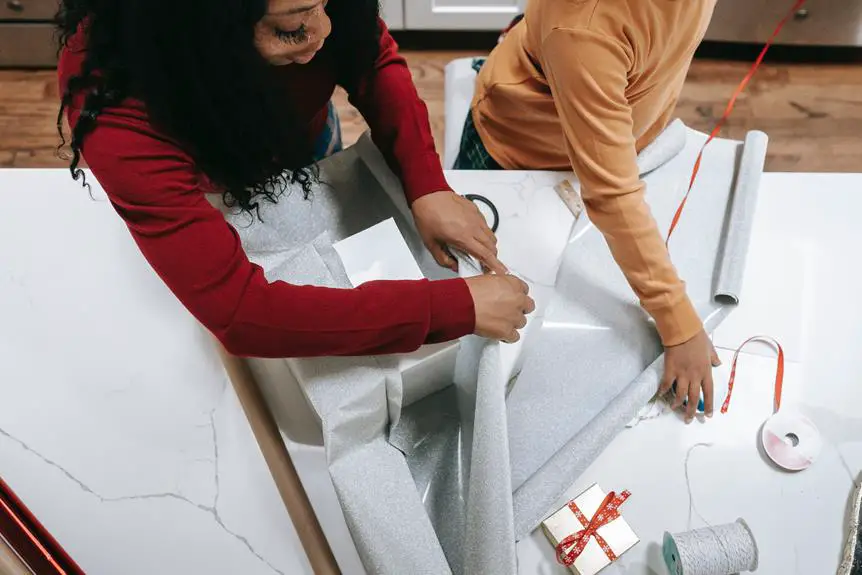Looking to mend your fabric with ease? Is Heat and Bond Hem Tape the ultimate fabric fix?
When it comes to repairing hems and seams, you seek a reliable solution. Discovering the best method can save you time and frustration.
Let's explore whether Heat and Bond Hem Tape lives up to its reputation as the ultimate fabric fix.
Key Takeaways
- Heat and Bond Hem Tape is a convenient and efficient alternative to traditional sewing hems.
- It provides a strong and durable hold, making it suitable for various fabrics such as denim, cotton, and polyester.
- While it is simple to apply and does not require sewing, it may not be as durable as traditional sewing and may not be suitable for delicate or stretchy fabrics.
- When choosing between Heat and Bond Hem Tape and traditional hemming, consider factors such as skill level, time constraints, and desired outcome.
How Heat and Bond Hem Tape Works
When you apply Heat and Bond Hem Tape to fabric, it bonds the layers together using heat and pressure, creating a strong and durable hold. This method of fabric bonding offers a convenient and efficient alternative to traditional sewing hems. The tape is designed to withstand washing and dry cleaning, making it a reliable choice for a wide range of fabrics and garments.
One of the key advantages of using Heat and Bond Hem Tape is its versatility. It can be used to create hems on various fabrics, including denim, cotton, and polyester. This flexibility makes it an ideal solution for quick repairs or alterations, as well as for creating seamless hems on new projects.
Furthermore, Heat and Bond Hem Tape provides a clean and professional finish without the need for sewing. This makes it particularly useful for individuals who may not have access to a sewing machine or for those who want to achieve a polished look without extensive sewing skills.
Advantages of Using Heat and Bond Hem Tape
If you're looking for a quick and easy way to create durable and professional fabric hems, using Heat and Bond Hem Tape offers numerous advantages.
One of the key benefits is its simplicity of application. Unlike traditional sewing methods, this tape requires no sewing, making it ideal for those who are new to crafting or for quick repairs.
The tape is also versatile, suitable for a wide range of fabrics, from lightweight to heavy materials. Its adhesive strength ensures a long-lasting hold, even after multiple washes, providing a reliable solution for hemming garments, curtains, and more.
Additionally, Heat and Bond Hem Tape creates a clean and seamless finish, giving your hems a professional look without the need for intricate stitching. This makes it an excellent choice for those seeking a polished result without the time-consuming effort of traditional hemming techniques.
With its ease of use, durability, and professional results, Heat and Bond Hem Tape is a valuable tool for anyone looking to achieve high-quality fabric hems.
Potential Drawbacks of Heat and Bond Hem Tape
While Heat and Bond Hem Tape offers many advantages, it's important to consider the potential drawbacks of its use. One potential issue with Heat and Bond Hem Tape is that it may not be as durable as traditional sewing. While it provides a quick and easy fix for hems and seams, the bond created by the tape may not withstand frequent laundering or heavy use as well as a stitched hem.
Additionally, Heat and Bond Hem Tape may not be suitable for all types of fabric. Delicate or stretchy fabrics may not adhere well to the tape, leading to potential limitations in its application.
It's also important to note that while Heat and Bond Hem Tape is convenient, there are alternatives that may better suit certain projects. For example, using a sewing machine or hand stitching can provide a more secure and long-lasting hem for certain fabrics. These alternatives may require more time and skill, but they can offer a more reliable and durable finish, especially for high-wear garments.
Considering these potential drawbacks and limitations, it's essential to weigh the convenience of Heat and Bond Hem Tape against the long-term durability and suitability for specific fabric types.
Tips for Applying Heat and Bond Hem Tape
To apply Heat and Bond Hem Tape successfully, gather the necessary materials and prepare the fabric according to the product instructions. Start by ensuring that the fabric is clean and dry before applying the tape.
Lay the fabric on a flat surface and measure and mark the hem allowance. Then, cut the tape to the required length and place it between the fabric layers with the adhesive side down.
Use a pressing cloth to cover the fabric and apply a dry iron with firm pressure for about 8-10 seconds. Allow the fabric to cool completely before checking the bond. If the bond isn't secure, repeat the ironing process until the tape adheres firmly.
It's important to avoid using steam during the bonding process as it can affect the adhesive. Additionally, always test a small area of the fabric first to ensure compatibility and to determine the appropriate heat setting for your iron.
Following these tips will help you achieve strong and durable fabric bonding for quick fixes.
Comparing Heat and Bond Hem Tape to Traditional Hemming
When comparing Heat and Bond Hem Tape to traditional hemming, efficiency becomes a key consideration. Sewing versus bonding presents a fundamental choice in fabric fixing. Traditional hemming involves sewing the fabric to create a secure and polished edge, while Heat and Bond Hem Tape offers a bonding method using heat to adhere the hem in place. Both techniques have their advantages and drawbacks, and the choice between them often comes down to the specific needs of the project and the time available for completion. Here's a comparison table to help you weigh the options:
| Aspect | Sewing | Heat and Bond Hem Tape |
|---|---|---|
| Application Time | More time-consuming | Quick and efficient |
| Skill Required | Requires sewing skills | No sewing skills needed |
| Durability | Durable and long-lasting | May peel over time |
| Flexibility | Allows for adjustments | Less flexibility |
| Professional Finish | Neat and traditional | Clean and modern |
In terms of time-saving techniques, Heat and Bond Hem Tape offers a quicker solution, especially for those who are less experienced with sewing. However, traditional hemming provides a durable and professional finish, with the added flexibility to make adjustments during the process. When deciding between the two methods, consider your skill level, time constraints, and the desired outcome for your project.
Frequently Asked Questions
Can Heat and Bond Hem Tape Be Used on All Types of Fabric, Including Delicate or Stretchy Materials?
Yes, Heat and Bond Hem Tape can be used on all types of fabric, including delicate or stretchy materials. To ensure success, use a lower heat setting and a press cloth when applying to delicate or stretchy fabrics.
Is It Possible to Remove Heat and Bond Hem Tape Once It Has Been Applied, or Is It a Permanent Fix?
Yes, you can remove Heat and Bond hem tape once it's been applied. It's not a permanent fix, giving you the flexibility to adjust or reuse the fabric. This feature makes it a versatile and practical option for various fabric projects.
Can Heat and Bond Hem Tape Withstand Frequent Washing and Drying Without Coming Unstuck or Causing Damage to the Fabric?
With frequent washing and drying, Heat and Bond Hem Tape can withstand long term durability, especially when used with compatible fabrics. It provides a reliable fix and is suitable for maintaining fabric integrity.
Are There Any Specific Types of Clothing or Garments That Heat and Bond Hem Tape Is Not Suitable For?
When considering types of clothing, hem tape limitations, and fabric suitability, it's essential to assess the removal process, durability, and fabric compatibility. Different applications may suit straight vs. curved hems, and some fabrics may not be compatible.
Does Heat and Bond Hem Tape Work Well for Both Straight and Curved Hems, or Is It More Effective for One Type Over the Other?
For both straight hems and curved hems, Heat and Bond Hem Tape can provide a reliable fabric fix. It offers a permanent solution for securing hems in various shapes, making it a versatile choice for your sewing projects.
- How Does Ring Spun Cotton Affect Garment Fit and Shape Retention? - August 13, 2024
- What Are the Challenges in Producing Ring Spun Cotton? - August 13, 2024
- Is Ring Spun Cotton Suitable for Plus-Size Clothing? - August 13, 2024



